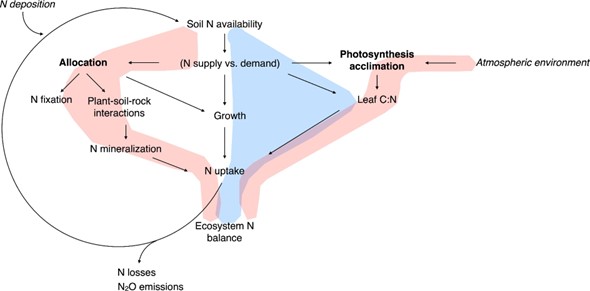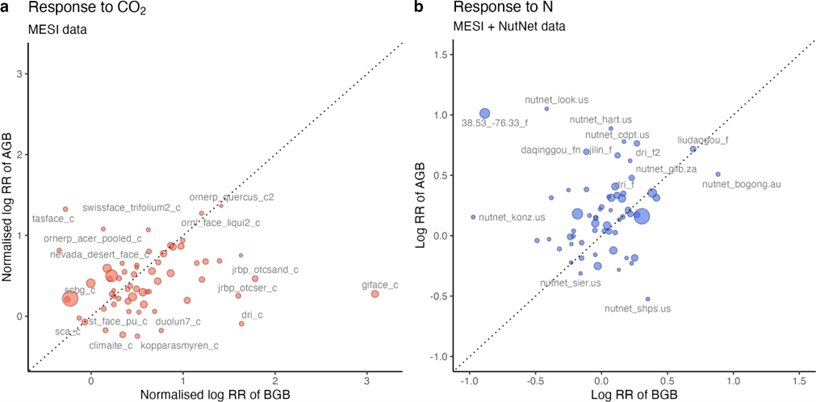We’re thrilled to announce the publication of our new Tansley Review in New Phytologist, on the complex interactions between carbon and nitrogen cycles in ecosystems. This paper has been a labour of love, years in the making, and we owe a tremendous thank you to our Nitrogen Working Group—now known as the C, N, P Cycles Synthesis Working Group—led by Dr. Beni Stocker from Bern University.
Exploring Carbon and Nitrogen Cycle Interactions
In our review, we examine how different models depict the relationships between carbon (C) and nitrogen (N) cycles within land ecosystems. These interactions are crucial for understanding how plants function and respond to environmental changes and how plant functioning affects the carbon cycle. Our findings indicate that existing modelling approaches often lead to inconsistent simulations of historical land carbon balance trends. Given the recent advancements in theory and data, it’s clear that we need to reassess how we understand these processes, especially concerning plant responses to varying levels of CO₂ and nitrogen inputs.
Why Carbon and Nitrogen Cycles Matter
Understanding soil nutrients, particularly nitrogen, is essential for predicting how terrestrial ecosystems can help mitigate climate change. The carbon and nitrogen cycles are tightly interconnected; nitrogen is a critical nutrient for plant growth, influencing carbon uptake and storage in terrestrial ecosystems. Our research highlights the challenges of accurately modelling the interactions between the carbon and nitrogen cycles, which is vital for reducing uncertainties in climate-carbon feedback predictions.
Historically, nitrogen has often been overlooked in models focused primarily on carbon dynamics. Early models predicted large increases in biomass with rising CO₂ levels, assuming that carbon was the only limiting factor. However, this approach proved inadequate as it failed to account for the essential role of nitrogen, which can significantly influence plant productivity and ecosystem health. This oversight has led to the development of more advanced models that incorporate nitrogen dynamics, yet discrepancies still exist in how ecosystems respond to increased CO₂ and nitrogen fertilization.
Current Modelling Approaches
Today’s models implement diverse assumptions for representing carbon-nitrogen interactions, leading to inconsistencies in understanding key processes. For example, some models assume a linear relationship between nitrogen uptake and soil nitrogen content, while others employ a saturating function to reflect the complexities of nitrogen dynamics in soils. Additionally, allocation strategies vary: many models maintain a constant balance between aboveground and belowground biomass, while others allow flexibility based on nitrogen availability.
Furthermore, while some models link photosynthetic capacity directly to leaf nitrogen content, others treat these relationships as independent variables. This divergence in modelling approaches undermines the robustness of projections of how ecosystems function and respond to changes in climate and rising CO2.
Many models tend to underestimate flexibility in nitrogen allocation, implying limited capacity to adjust their nitrogen uptake in response to environmental changes and altered plant growth. Moreover, they often underestimate or neglect the direct effects of the atmospheric environment —such as temperature, humidity of the air and CO2 — on leaf nitrogen content. Consequently, these models may not accurately capture the effects of rising CO₂ levels and climate change on nitrogen demand, leading to biased projections of carbon and nitrogen cycle changes.
Our review advocates for incorporating eco-evolutionary optimality (EEO) theory into future models. This theoretical framework emphasises that plants optimise their resource allocation to maximise growth and reproductive success, offering valuable insights into how plants acclimate to changes in nitrogen availability.

Figure 1: Pathways of carbon-nitrogen interactions in terrestrial ecosystems. The blue background indicates the traditional approach in many Dynamic Global Vegetation Models (DGVMs), where atmospheric factors (temperature, radiation, vapor pressure deficit, and CO2) do not directly affect leaf carbon-to-nitrogen (C) ratios. The pathways highlighted in red underscore the importance of incorporating these interactions, particularly how soil nitrogen availability influences carbon allocation. Direct effects of the atmospheric environment on leaf acclimation also impact leaf C:N ratios and subsequently influence ecosystem nitrogen cycling.
Ecosystem Manipulation Experiments
Ecosystem manipulation experiments have provided valuable data on the coupling of carbon and nitrogen cycles. Our review includes a meta-analysis of experiments focussed on plant responses to CO₂ and nitrogen fertilisation. These experiments reveal key trends that enhance our understanding of these cycles.
One significant finding is that nitrogen fertilisation generally increases leaf nitrogen content. However, this increase in nitrogen does not always lead to a corresponding rise in leaf photosynthesis. This disconnect suggests that other factors, such as the availability of other nutrients or environmental conditions, may also play a critical role in determining photosynthetic rates.
Interestingly, while nitrogen uptake improves with fertilisation, root biomass production often remains unchanged or even decreases. This indicates a potential reallocation of resources toward aboveground growth, possibly as plants prioritise their investment in leaves and stems to capture more sunlight and enhance photosynthetic capacity.
The analysis also showed that increased nitrogen uptake efficiency correlates with greater aboveground biomass, highlighting the importance of nitrogen availability for plant growth. However, the relationship between nitrogen fertilisation and photosynthetic capacity is complex, as enhanced leaf nitrogen does not consistently translate into increased photosynthesis rates. This phenomenon is evident from discrepancies in reported increases in assimilation rates compared to biomass changes across various experiments, illustrating the multifaceted nature of these interactions.
The Impact of Elevated CO₂
Elevated CO₂ levels generally promote an increase in leaf area and biomass, similar to nitrogen fertilisation. However, CO₂ has a more substantial effect on belowground production, leading to increased root growth. This increase in root biomass can potentially deplete soil nitrogen, creating a negative feedback loop where enhanced nitrogen uptake may limit growth responses driven by CO₂ in nitrogen-poor soils.
Importantly, while nitrogen uptake tends to rise under elevated CO₂, leaf nitrogen content often decreases and reduced soil N availability is accompanied by reduced N losses. This suggests a potential mechanism by which nitrogen limitations on biomass production in response to elevated CO₂ could be alleviated in the long-term. As plants experience higher CO₂ levels in future decades, reduced nitrogen demand and reduced losses may support a continuation of increased growth.

Figure 2: Simultaneous response ratios of aboveground and belowground biomass for (a) CO₂ experiments and (b) nitrogen fertilization experiments. Each point represents the average log-transformed ratio of means across all years for a single experiment, with point size reflecting the inverse of the standard error of the log response ratio. For nitrogen fertilization experiments, data is filtered to manipulations below 30 g N m² yr⁻¹ for comparability. In CO₂ experiments, the log response ratio is normalized using the log-transformed ratio of control and elevated CO₂ levels.
Leaf Traits and Photosynthetic Capacity
Dynamic Global Vegetation Models (DGVMs) are particularly sensitive to how leaf traits, especially nitrogen content, are represented. Our review underscores that while increased nitrogen availability can boost leaf nitrogen content, it does not always enhance photosynthetic capacity, challenging long-held assumptions in ecological modelling.
The findings indicate that as soil nitrogen increases, the correlation between leaf nitrogen and photosynthetic capacity weakens, revealing a more nuanced interaction than previously understood. This complexity suggests that factors such as leaf mass per area (LMA) play a crucial role in determining leaf nitrogen content. Environmental variables, such as soil carbon-to-nitrogen ratios, significantly influence these dynamics, complicating our understanding of how nitrogen and carbon cycles interact in different ecosystems.
Conclusions
Our review emphasises the pressing need for models that reflect key pathways of carbon and nitrogen interactions in ecosystems that we have identified in this review. By integrating insights from extensive datasets on leaf traits and findings from ecosystem manipulation experiments, we aim to enhance the accuracy of future carbon cycle predictions and improve our understanding of how plants respond to environmental changes.
Although we have made significant strides in modelling carbon and nitrogen dynamics, ongoing variability in predictions highlights the importance of further research. Incorporating eco-evolutionary principles and make full use of available empirical data during model development and for benchmarking can improve our ability to simulate how ecosystems will respond to continued changes in CO₂ and nitrogen availability, ultimately contributing to better climate-carbon feedback projections.
Read the full paper here:
Stocker, B.D., Dong, N., Perkowski, E.A., Schneider, P.D., Xu, H., de Boer, H., Rebel, K.T., Smith, N.G., Van Sundert, K., Wang, H., Jones, S.E., Prentice, I.C., & Harrison, S.P. 2024. Tansley Review. Empirical evidence and theoretical understanding of ecosystem carbon and nitrogen cycle interactions. New Phytologist. DOI: 10.1111/nph.20178.
